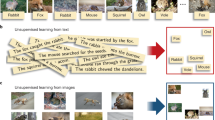Abstract
THERE is a simple rule that defines which of the symbols of Fig. 1 fall into group A and which into group B. It can be expressed in thirteen words, but the reader is unlikely to guess it—even if we tell him that the only relevant differences between the patterns are in symmetry, dot colour and dot shape.
This is a preview of subscription content, access via your institution
Access options
Subscribe to this journal
Receive 51 print issues and online access
$199.00 per year
only $3.90 per issue
Buy this article
- Purchase on Springer Link
- Instant access to full article PDF
Prices may be subject to local taxes which are calculated during checkout
Similar content being viewed by others
References
Ryle, G., Proc. Arist. Soc. (supp. series), 25, 65 (1951).
Urmson, J. O., in Ryle (edit. by Wood, O. P., and Pitcher, G.), 249 (Macmillan, London, 1971).
Bruner, J. S., Goodnow, J. J., and Austin, G. A., A Study of Thinking (Wiley, New York, 1956).
Kendall, M. G., Rank Correlation Methods, third ed. (Griffin, London, 1962).
Ryle, G., The Concept of Mind (Hutchinson, London, 1951).
Wittgenstein, L., Philosophical Investigations, third ed. (Blackwell, Oxford, 1968).
Neisser, U., Cognitive Psychology, 58 and 180 (Appleton-Century-Crofts, New York, 1967).
Author information
Authors and Affiliations
Rights and permissions
About this article
Cite this article
DENNIS, I., HAMPTON, J. & LEA, S. New Problem in Concept Formation. Nature 243, 101–102 (1973). https://doi.org/10.1038/243101a0
Received:
Revised:
Issue Date:
DOI: https://doi.org/10.1038/243101a0
This article is cited by
-
Labeling and family resemblance in the discrimination of polymorphous categories by pigeons
Animal Cognition (2011)
-
Conceptual clustering, categorization, and polymorphy
Machine Learning (1989)
-
Differential Inhibition of Catabolite-sensitive Enzyme Induction by Intercalating Dyes
Nature New Biology (1973)
Comments
By submitting a comment you agree to abide by our Terms and Community Guidelines. If you find something abusive or that does not comply with our terms or guidelines please flag it as inappropriate.



